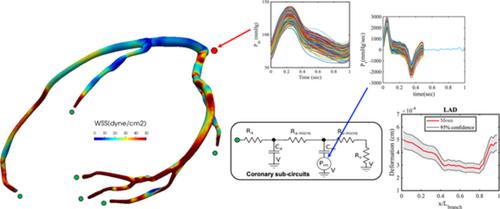当前位置:
X-MOL 学术
›
Int. J. Numer. Method. Biomed. Eng.
›
论文详情
Our official English website, www.x-mol.net, welcomes your feedback! (Note: you will need to create a separate account there.)
The effects of clinically-derived parametric data uncertainty in patient-specific coronary simulations with deformable walls.
International Journal for Numerical Methods in Biomedical Engineering ( IF 2.1 ) Pub Date : 2020-06-25 , DOI: 10.1002/cnm.3351 Jongmin Seo 1 , Daniele E Schiavazzi 2 , Andrew M Kahn 3 , Alison L Marsden 1
International Journal for Numerical Methods in Biomedical Engineering ( IF 2.1 ) Pub Date : 2020-06-25 , DOI: 10.1002/cnm.3351 Jongmin Seo 1 , Daniele E Schiavazzi 2 , Andrew M Kahn 3 , Alison L Marsden 1
Affiliation

|
Cardiovascular simulations are increasingly used for noninvasive diagnosis of cardiovascular disease, to guide treatment decisions, and in the design of medical devices. Quantitative assessment of the variability of simulation outputs due to input uncertainty is a key step toward further integration of cardiovascular simulations in the clinical workflow. In this study, we present uncertainty quantification in computational models of the coronary circulation to investigate the effect of uncertain parameters, including coronary pressure waveform, intramyocardial pressure, morphometry exponent, and the vascular wall Young's modulus. We employ a left coronary artery model with deformable vessel walls, simulated via an Arbitrary‐Lagrangian‐Eulerian framework for fluid‐structure interaction, with a prescribed inlet pressure and open‐loop lumped parameter network outlet boundary conditions. Stochastic modeling of the uncertain inputs is determined from intra‐coronary catheterization data or gathered from the literature. Uncertainty propagation is performed using several approaches including Monte Carlo, Quasi Monte Carlo sampling, stochastic collocation, and multi‐wavelet stochastic expansion. Variabilities in the quantities of interest, including branch pressure, flow, wall shear stress, and wall deformation are assessed. We find that uncertainty in inlet pressures and intramyocardial pressures significantly affect all resulting QoIs, while uncertainty in elastic modulus only affects the mechanical response of the vascular wall. Variability in the morphometry exponent used to distribute the total downstream vascular resistance to the single outlets, has little effect on coronary hemodynamics or wall mechanics. Finally, we compare convergence behaviors of statistics of QoIs using several uncertainty propagation methods on three model benchmark problems and the left coronary simulations. From the simulation results, we conclude that the multi‐wavelet stochastic expansion shows superior accuracy and performance against Quasi Monte Carlo and stochastic collocation methods.
中文翻译:

临床衍生参数数据不确定性在具有可变形壁的患者特异性冠状动脉模拟中的影响。
心血管模拟越来越多地用于心血管疾病的无创诊断、指导治疗决策以及医疗设备的设计。由于输入不确定性而对模拟输出的可变性进行定量评估是进一步将心血管模拟集成到临床工作流程中的关键一步。在这项研究中,我们在冠状循环的计算模型中提出了不确定性量化,以研究不确定参数的影响,包括冠状动脉压力波形、心肌内压力、形态测量指数和血管壁杨氏模量。我们采用具有可变形血管壁的左冠状动脉模型,通过任意-拉格朗日-欧拉框架模拟流体-结构相互作用,具有规定的入口压力和开环集总参数网络出口边界条件。不确定输入的随机建模由冠状动脉内导管插入数据确定或从文献中收集。不确定性传播使用多种方法进行,包括蒙特卡罗、准蒙特卡罗采样、随机搭配和多小波随机扩展。评估感兴趣的数量的变化,包括分支压力、流量、壁面剪应力和壁面变形。我们发现入口压力和心肌内压力的不确定性显着影响所有产生的 QoI,而弹性模量的不确定性仅影响血管壁的机械响应。用于将总下游血管阻力分配到单个出口的形态测量指数的可变性对冠状动脉血流动力学或壁力学几乎没有影响。最后,我们在三个模型基准问题和左冠状动脉模拟上使用几种不确定性传播方法比较了 QoI 统计的收敛行为。从模拟结果中,我们得出结论,多小波随机扩展相对于准蒙特卡罗和随机搭配方法显示出优异的准确性和性能。
更新日期:2020-06-25
中文翻译:

临床衍生参数数据不确定性在具有可变形壁的患者特异性冠状动脉模拟中的影响。
心血管模拟越来越多地用于心血管疾病的无创诊断、指导治疗决策以及医疗设备的设计。由于输入不确定性而对模拟输出的可变性进行定量评估是进一步将心血管模拟集成到临床工作流程中的关键一步。在这项研究中,我们在冠状循环的计算模型中提出了不确定性量化,以研究不确定参数的影响,包括冠状动脉压力波形、心肌内压力、形态测量指数和血管壁杨氏模量。我们采用具有可变形血管壁的左冠状动脉模型,通过任意-拉格朗日-欧拉框架模拟流体-结构相互作用,具有规定的入口压力和开环集总参数网络出口边界条件。不确定输入的随机建模由冠状动脉内导管插入数据确定或从文献中收集。不确定性传播使用多种方法进行,包括蒙特卡罗、准蒙特卡罗采样、随机搭配和多小波随机扩展。评估感兴趣的数量的变化,包括分支压力、流量、壁面剪应力和壁面变形。我们发现入口压力和心肌内压力的不确定性显着影响所有产生的 QoI,而弹性模量的不确定性仅影响血管壁的机械响应。用于将总下游血管阻力分配到单个出口的形态测量指数的可变性对冠状动脉血流动力学或壁力学几乎没有影响。最后,我们在三个模型基准问题和左冠状动脉模拟上使用几种不确定性传播方法比较了 QoI 统计的收敛行为。从模拟结果中,我们得出结论,多小波随机扩展相对于准蒙特卡罗和随机搭配方法显示出优异的准确性和性能。


























 京公网安备 11010802027423号
京公网安备 11010802027423号